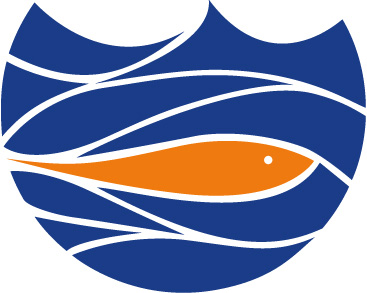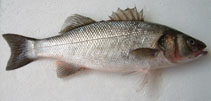http://www.fishbase.org/Summary/speciesSummary.php?genusname=Dicentrarchus&speciesname=labrax ---> http://fishbase.de/Summary/speciesSummary.php?genusname=Dicentrarchus&speciesname=labrax
http://fishbase.de/Summary/speciesSummary.php?genusname=Dicentrarchus&speciesname=labrax ---> https://fishbase.de/Summary/speciesSummary.php?genusname=Dicentrarchus&speciesname=labrax
https://fishbase.de/Summary/speciesSummary.php?genusname=Dicentrarchus&speciesname=labrax ---> http://fishbase.de/summary/Dicentrarchus-labrax.html
http://fishbase.de/summary/Dicentrarchus-labrax.html ---> https://fishbase.de/summary/Dicentrarchus-labrax.html
Dicentrarchus labrax, European seabass : fisheries, aquaculture, gamefish

You can
sponsor
this page
Common name (e.g. trout)
Genus + Species (e.g. Gadus morhua)
-

-
About this page
-
Languages
-
User feedbacks
-
Citation
-
Uploads
-
Related species
-


 European seabass
Add your observation in
Fish Watcher
Upload your
photos
and
videos
European seabass
Add your observation in
Fish Watcher
Upload your
photos
and
videos
Pictures
|
Videos |
Google image
 Dicentrarchus labrax
Dicentrarchus labrax
Picture by
Crocetta, F.
Teleostei (teleosts) >
Eupercaria/misc
(Various families in series Eupercaria) >
Moronidae
(Temperate basses)
Etymology:
Dicentrarchus:
Greek, di = two + Greek, kentron = sting + Greek, archos = anus (Ref.
45335
)
.
More on author:
Linnaeus
.
Environment: milieu / climate zone / depth range / distribution range
Ecology
Marine; freshwater; brackish; demersal; oceanodromous; depth range 10 - 100 m (Ref.
9987
). Subtropical; 8°C - 24°C (Ref.
4944
); 72°N - 11°N, 19°W - 42°E (Ref.
54221
)
Eastern Atlantic: Norway to Morocco, the Canary Islands and Senegal. Also known from the Mediterranean and Black Sea. Absent from White, Barents, Baltic and Caspian Seas (Ref.
59043
).
Length at first maturity / Size / Weight / Age
Maturity: L
m
36.1
, range 23 - 46 cm
Max length : 103 cm TL male/unsexed; (Ref.
40637
); common length : 50.0 cm TL male/unsexed; (Ref.
6916
); max. published weight: 12.0 kg (Ref.
1468
); max. reported age: 30 years (Ref.
59043
)
Dorsal
spines
(total): 8 - 10;
Dorsal
soft rays
(total): 12-13;
Anal
spines
: 3;
Anal
soft rays
: 10 - 12. Diagnosis: head with cycloid scales above; mouth moderately protractile (Ref.
231
). Vomerine teeth only anteriorly (Ref.
231
), in a crescentic band (Ref.
231
,
57391
). Scales on interorbital space cycloid (Ref.
57391
). Posterior edge of opercle finely serrated, lower edge with strong forward- directed denticles (Ref.
231
). 2 flat opercular spines (Ref.
231
,
57391
). Young with some dark spots on upper part of body (Ref.
231
).
Adults manifest demersal behavior, inhabit coastal waters down to about 100 m depth but more common in shallow waters (Ref.
54221
,
57391
). Found in the littoral zone on various kinds of bottoms on estuaries, lagoons and occasionally rivers. They enter coastal waters and river mouths in summer, but migrate offshore in colder weather and occur in deep water during winter in the northern range. Young fish form school, but adults appear to be less gregarious (Ref.
9987
). Feed chiefly on shrimps and mollusks, also on fishes (Ref.
5990
). Juveniles feed on invertebrates, taking increasingly more fish with age. Adults piscivorous . (Ref.
59043
). Spawn in batches (Ref.
51846
). Spawning takes place in the spring near the British Isles, and earlier in its southern range. Eggs are pelagic (Ref.
35388
). Marketed fresh or smoked (Ref.
9987
). Highly sought by sport fishermen (Ref.
30578
).
Spawn in groups. Eggs are pelagic. In the Mediterranean, first sexual maturity occurs generally between 2 and 4 years of age while in the Atlantic sexual maturity happens a little later (males between 4-7 years and females between 5-8 years). Spawning happens just once a year and it tends to be in winter, although in southern areas it can occur in spring. Eggs have 1-2 fat drops that fuse about 12 hours after laying. Embryo development lasts about three days at 13-14°C and larval development about 40 days at 19°C. Egg size 1.1-1.5 mm, larval length at hatching 3 mm.
Smith, C.L.
, 1990. Moronidae. p. 692-694. In J.C. Quero, J.C. Hureau, C. Karrer, A. Post and L. Saldanha (eds.) Check-list of the fishes of the eastern tropical Atlantic (CLOFETA). JNICT, Lisbon; SEI, Paris; and UNESCO, Paris. Vol. 2. (Ref.
6916
)
IUCN Red List Status (Ref.
130435
)
Least Concern (LC)
; Date assessed:
01 January 2008
CITES
Not Evaluated
Not Evaluated
Threat to humans
Harmless
Human uses
Fisheries: commercial; aquaculture: commercial; gamefish: yes
FAO - Aquaculture:
production
,
species profile
; Fisheries:
landings
,
species profile
; Publication:
search
|
FishSource
|
Sea Around Us
More information
Countries
FAO areas
Ecosystems
Occurrences
Introductions
Stocks
Ecology
Diet
Food items
Food consumption
Ration
Common names
Synonyms
Metabolism
Predators
Ecotoxicology
Reproduction
Maturity
Spawning
Spawning aggregation
Fecundity
Eggs
Egg development
Age/Size
Growth
Length-weight
Length-length
Length-frequencies
Morphometrics
Morphology
Larvae
Larval dynamics
Recruitment
Abundance
BRUVS
References
Aquaculture
Aquaculture profile
Strains
Genetics
Electrophoreses
Heritability
Diseases
Processing
Nutrients
Mass conversion
Collaborators
Pictures
Stamps, Coins Misc.
Sounds
Ciguatera
Speed
Swim. type
Gill area
Otoliths
Brains
Vision
Tools
E-book
|
Field guide
|
Identification keys
|
Length-frequency wizard
|
Life-history tool
|
Point map
|
Classification Tree
|
Catch-MSY
|
Special reports
Check for Aquarium maintenance
|
Check for Species Fact Sheets
|
Check for Aquaculture Fact Sheets
Download XML
Summary page
|
Point data
|
Common names
|
Photos
Internet sources
AFORO (otoliths)
|
Alien/Invasive Species database
|
Aquatic Commons
|
BHL
|
Cloffa
|
BOLDSystems
|
Websites from users
|
Check FishWatcher
|
CISTI
|
Catalog of Fishes
:
genus
,
species
|
DiscoverLife
|
DORIS
|
ECOTOX
| FAO - Aquaculture:
production
,
species profile
; Fisheries:
landings
,
species profile
; Publication:
search
|
Faunafri
|
Fishipedia
|
Fishtrace
| GenBank:
genome
,
nucleotide
|
GloBI
|
Google Books
|
Google Scholar
|
Google
|
IGFA World Record
|
MitoFish
|
National databases
| OsteoBase:
skull
,
spine
|
Otolith Atlas of Taiwan Fishes
|
Public aquariums
|
PubMed
| Reef Life Survey | Socotra Atlas |
Tree of Life
| Wikipedia:
Go
,
Search
| World Records Freshwater Fishing |
Zoological Record
Estimates based on models
Preferred temperature (Ref.
123201
): 7.3 - 19.5, mean 10.7 °C (based on 788 cells).
Phylogenetic diversity index (Ref.
82804
): PD
50
= 0.7656 [Uniqueness, from 0.5 = low to 2.0 = high].
Bayesian length-weight: a=0.00933 (0.00777 - 0.01121), b=3.02 (2.96 - 3.08), in cm total length, based on LWR estimates for this species (Ref.
93245
).
Trophic level (Ref.
69278
): 3.5 ±0.50 se; based on food items.
Generation time: 7.8 (5.0 - 11.0) years. Estimated as median ln(3)/K based on 33
growth studies.
Resilience (Ref.
120179
): Medium, minimum population doubling time 1.4 - 4.4 years (K=0.06-0.33; tm=2-8; tmax=30; Fec=230,000).
Prior r = 0.54, 95% CL = 0.35 - 0.84, Based on 14 stock assessments.
Fishing Vulnerability (Ref.
59153
): High to very high vulnerability (66 of 100).
Climate Vulnerability (Ref.
125649
): Moderate to high vulnerability (47 of 100).
Price category (Ref.
80766
):
Very high
.
Nutrients (Ref.
124155
): Calcium = 37.1 [4.5, 189.2] mg/100g; Iron = 0.869 [0.355, 2.011] mg/100g; Protein = 20.2 [19.3, 21.1] %; Omega3 = 0.3 [0.2, 0.5] g/100g; Selenium = 14.6 [7.0, 32.5] μg/100g; VitaminA = 7.01 [2.63, 20.46] μg/100g; Zinc = 0.519 [0.256, 1.128] mg/100g (wet weight); based on
nutrient studies.
Back to Search
Random Species
Back to Top
Accessed through:
Not available
FishBase mirror site :
localhost
Page last modified by :
mrius-barile
- 20 July 2016
Fatal error
: Uncaught ArgumentCountError: Too few arguments to function checkEcotox(), 1 passed in /var/www/html/summary/SpeciesSummary.php on line 2304 and exactly 3 expected in /var/www/html/includes/speciessummary.lib.php:2580 Stack trace: #0 /var/www/html/summary/SpeciesSummary.php(2304): checkEcotox() #1 {main} thrown in
/var/www/html/includes/speciessummary.lib.php
on line
2580
|